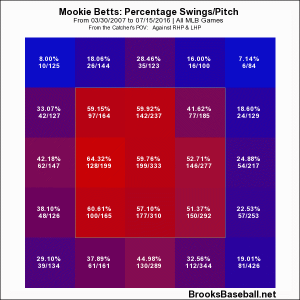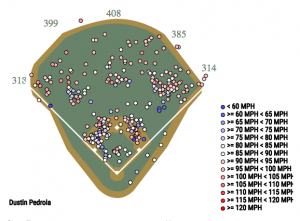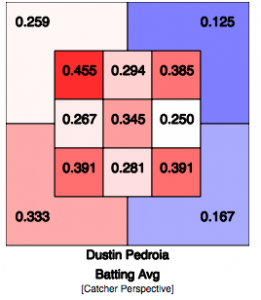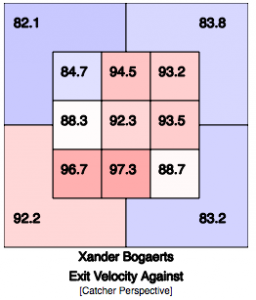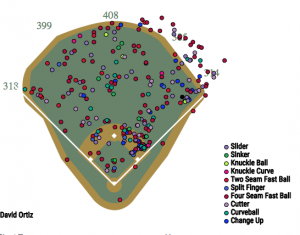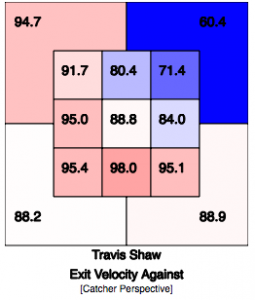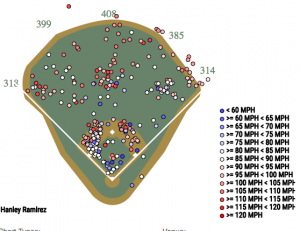The Red Sox came into the Bronx with a record of 49-38, a division-leading 5.6 runs scored per game, and just 4.8 against. While underperforming their pythagorean record, the Sox traded for Drew Pomeranz who has accumulated more WARP in 2016 than he has in his entire career. The Red Sox front office preferred to give their 900-run offense support now while sending the young, heralded Anderson Espinosa to San Diego. The return for the Padres is somewhat shocking given Pomeranz was just acquired seven months ago for Yonder Alonso and Mark Rzepczynski.
Speaking of that 900-run offense, let’s take a look at the hitters that have carried the Red Sox so far this season.
Mookie Betts
Betts has an 11-game hitting streak and is 18 of 40 this month with seven extra base hits. Leading the team with 3.5 WARP (2.2 PECOTA rest of season), he is a great player that sprays the ball with power to all fields. Coming in with average exit velocities off Pineda at 92 mph, Sabathia 85, and Tanaka at 92. His average launch angle of 10 degrees, which is that of a prototypical line drive, is a reason Betts has scored 43 runs.
Attacking Betts is difficult because his hands are so quick. He does ground out to the short stop quiet often which pitchers mistake as an indication to throw hard and in to him. He is good at laying off the pitch up and in (10% swing and miss). The approach should be to throw him soft and away. This is the area where he misses the most.
Dustin Pedroia
He has shown improvement mainly defensively this year while playing in 85 games, tied for the team lead. One of the few Red Sox hitters to hit CC harder, at an exit velocity of 95 mph, 89 and 91 off Tanaka and Pineda, respectively. His True Average of .271 makes his .304 somewhat more pedestrian.
The Yankees should pitch Pedroia the outer third of the plate. Here is his exit velocity spray chart in Yankee Stadium.
Positioning Beltran closer to the line with Ellsbury shading the right center gap would produce more outs. A mistake cannot be made high and away, like the one he tomahawked against Severino on May 8th. He covers the corners well, so belt high in or out should be the plan.
Xander Bogaerts
Bogaerts has a surprisingly low average launch angle of 3.5 degrees. His combination of patience and contact within the zone (88%) make him one of the more dangerous in the Red Sox lineups. Like Pedroia, his .329 average is rather inflated compared to his TAv (.294). For both lefties and righties, throw the Aruban shortstop up and in.
David Ortiz
David Ortiz sure is not playing like a 40-year-old in his final season. Thus far he has produced a .342 TAv with an boisterous .426 OBP. As a whole, he hits an above average exit velocity (89 mph) from all quadrants of the zone. Pineda should pitch Ortiz carefully has his average exit velo is 99 mph of the big righty. Ortiz has hit the least amount of curveballs outs, produces lowest pull %, and lowest exit velocity off the curveball.
Travis Shaw
Of the hitters discussed Shaw has the highest average launch angle of 18 degrees. His 88 mph average exit velocity is somewhat misleading as he has been hitting the ball harder since the beginning of June. Shaw struggles with the ball up and in. He whiffs at a high number of fastballs (24%). With the lowest spray angle and exit velocity against offspeed, he should be approach soft and away, then finished with a fastball up and in.
Hanley Ramirez
Unlike the powerful Hanley the used to roam in Florida and Southern California, the Red Sox first baseman has been hitting a ton of ground balls – 6.4 degree average launch angle. Starting Hanley with fastballs (20% whiff) and then going to off-speed where his can’t seem to barrel changeups as well (86 MPH aEV). Below illustrated he hits his lowest points of contact to defensive clusters.
Photo: Brad Penner/USA Today Sports

